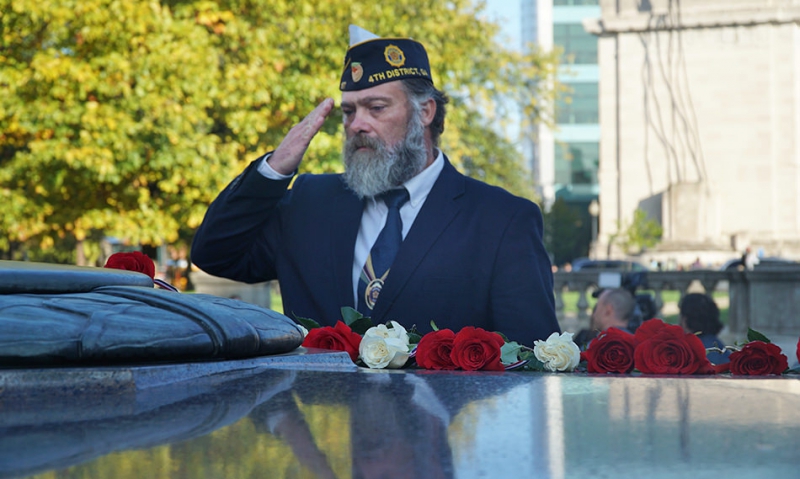
State lays wreath in memory of one of the first Americans to die in the Great War.
On Nov. 3, Hoosiers marked the 100th anniversary of the death of Army Cpl. James Gresham, one of the first American combat casualties of the Great War.
A native of Evansville, Ind., Gresham was killed in the early morning hours of Nov. 3, 1917, in a raid by the German army at Bathelemont, France. Two other soldiers -- Pvts. Merle Hay of Iowa and Thomas Enright of Pennsylvania -- died as well, though Gresham is often considered the first member of the American Expeditionary Forces (AEF) to lose his life in action.
The Indiana World War I Centennial Committee and the Indiana Daughters of the American Revolution (DAR) conducted a wreath-laying ceremony at the cenotaph on The American Legion Mall in downtown Indianapolis. The mall is part of the Indiana World War Memorial Plaza, built in the 1920s and home to The American Legion National Headquarters building.
"The properties we stand on today were conceived to commemorate the bravery, courage, valor and sacrifice of the soldiers, sailors and Marines of the United States, and all others who rendered faithful, loyal, heroic and self-sacrificing service overseas and at home in the Great War," said retired Brig. Gen. J. Stewart Goodwin, executive director of the Indiana World War I Centennial Committee.
Gresham was representative of the 135,000 Hoosiers who served, and the 3,300 who died, Goodwin said. Born in 1893, Gresham was the son of a Confederate Civil War veteran. He enlisted in the Army in 1914 and served under Gen. John Pershing during his pursuit of Pancho Villa in Mexico. After the United States entered the world war in April 1917, Gresham was among the first wave of doughboys sent to France.
Prior to the wreath-laying, James Glass, former deputy state historic preservation officer for Indiana, gave a historical review of Gresham's life and the circumstances of his death.
On Nov. 2, 1917, Gresham and the rest of Company F, 16th Infantry, 1st Division were training on the French battle line near Lorraine. At midnight, his platoon replaced French troops holding the line, and three hours later German shock troops attacked with an artillery barrage and cut off reinforcements.
"Fierce hand-to-hand fighting occurred," Glass said. "When the rest of the company finally broke through, they found Cpl. Gresham and two other Americans dead. Every indication ... showed they had put up a desperate fight but were hopelessly outnumbered."
Gresham's mother requested his body be returned to the United States after the war, and in 1921, people lined the streets of Indianapolis as Gresham's body was transported to the statehouse's rotunda for a second funeral. From there, he was taken to Locust Hill Cemetery in Evansville for final burial.
In 1933, Gresham's sacrifice was commemorated permanently in a sunken garden at the north end of the American Legion Mall. In the center of the garden is a black granite cenotaph, or symbolic sarcophagus, with this inscription: "A Tribute by Indiana to the Hallowed Memory of the Glorious Dead Who Served in the Great War." Close to it, on a red and dark green granite floor, is a bronze plate memorializing Gresham.
"A factory worker at the time of his enlistment, Gresham symbolized thousands of Hoosiers willing to give all for a cause not fully understood," said Lois Casey Huntington, Indiana state regent for the DAR. "He made the ultimate sacrifice and will never be forgotten."
Participants of National American Legion College attended the ceremony following their graduation.
"It grabbed my heart and made me appreciate all those who have fallen," said Mary Jane Fisher, a member of San Dieguito Post 416 in Encinitas, Calif., and the department's Recruiter of the Year. "We're wrapped up in the current wars, so to go back to that time, when The American Legion was born ... it was really good timing to be at American Legion College."
- Honor & Remembrance

